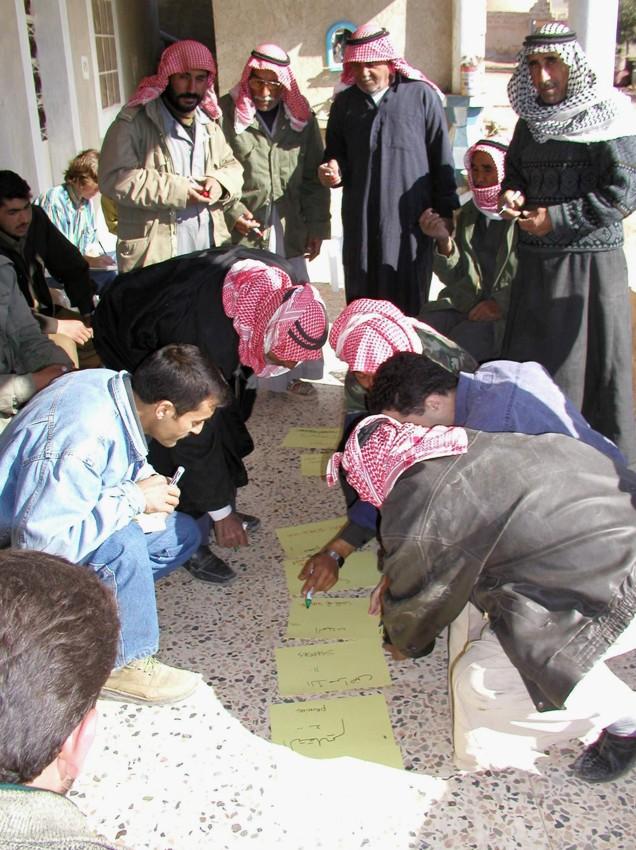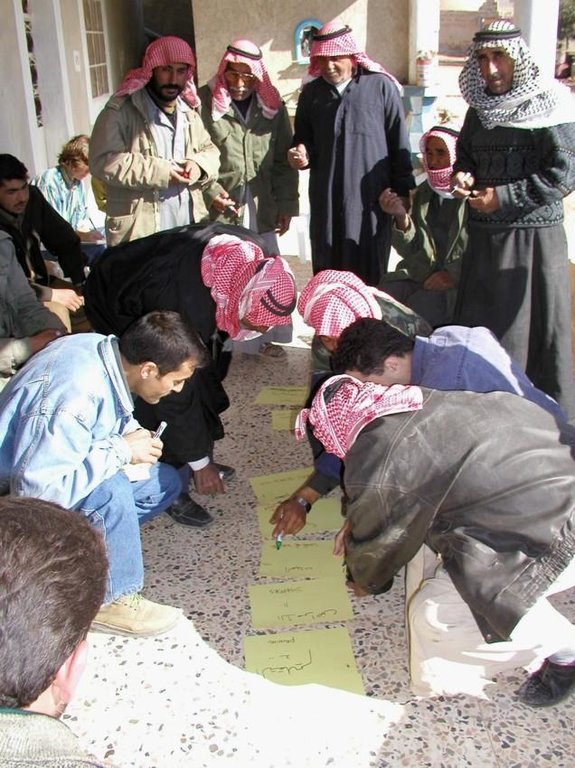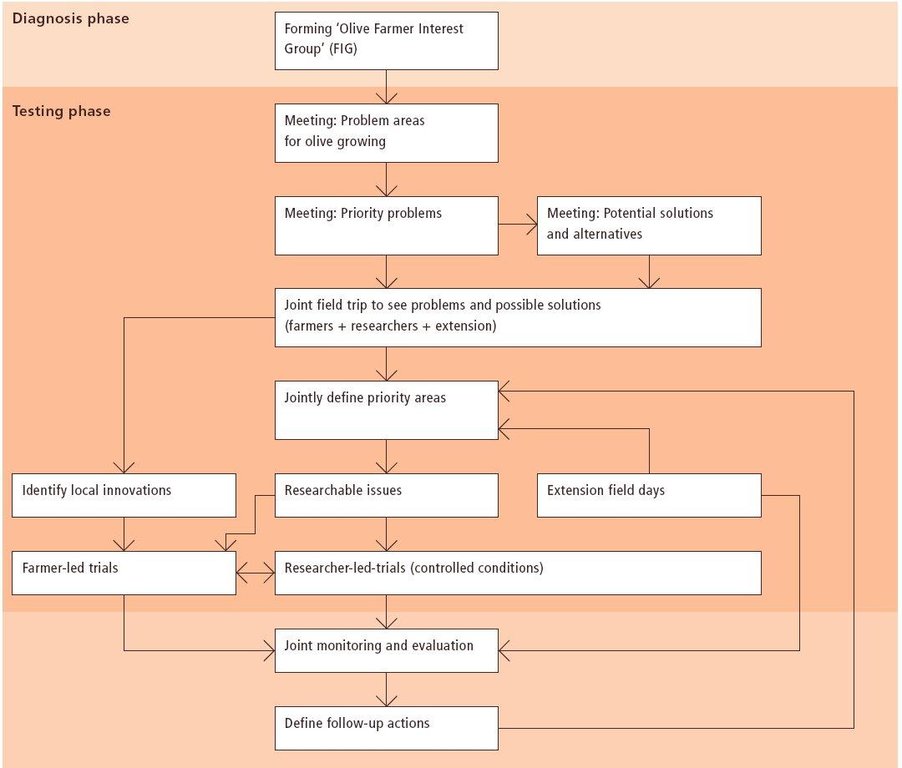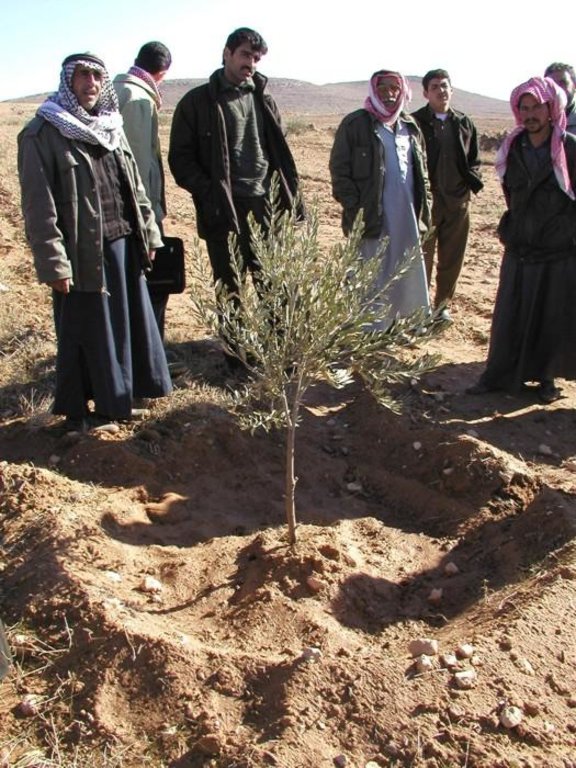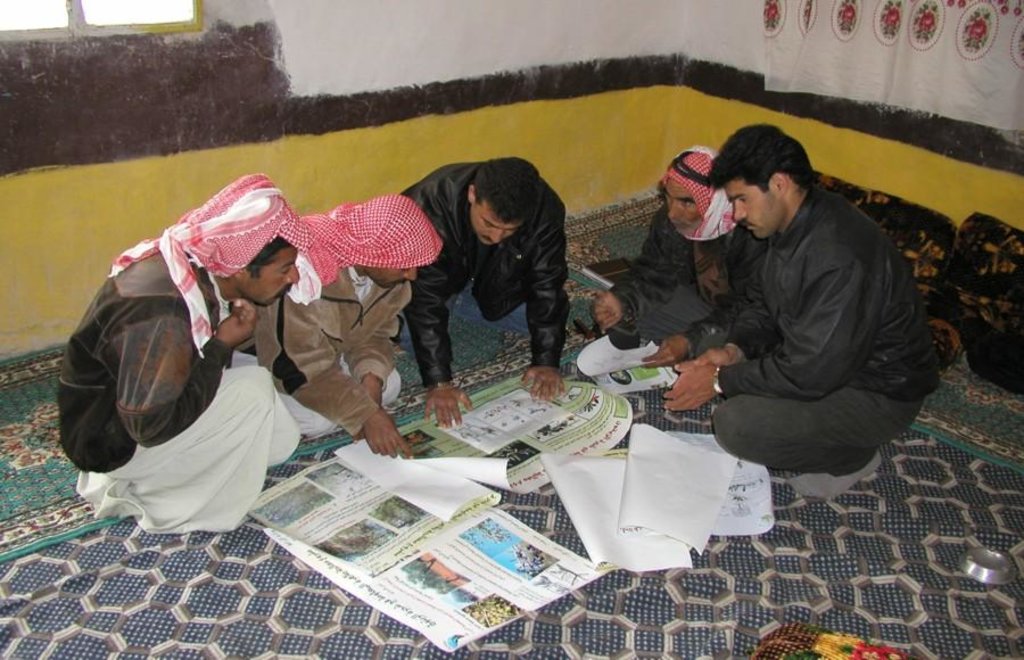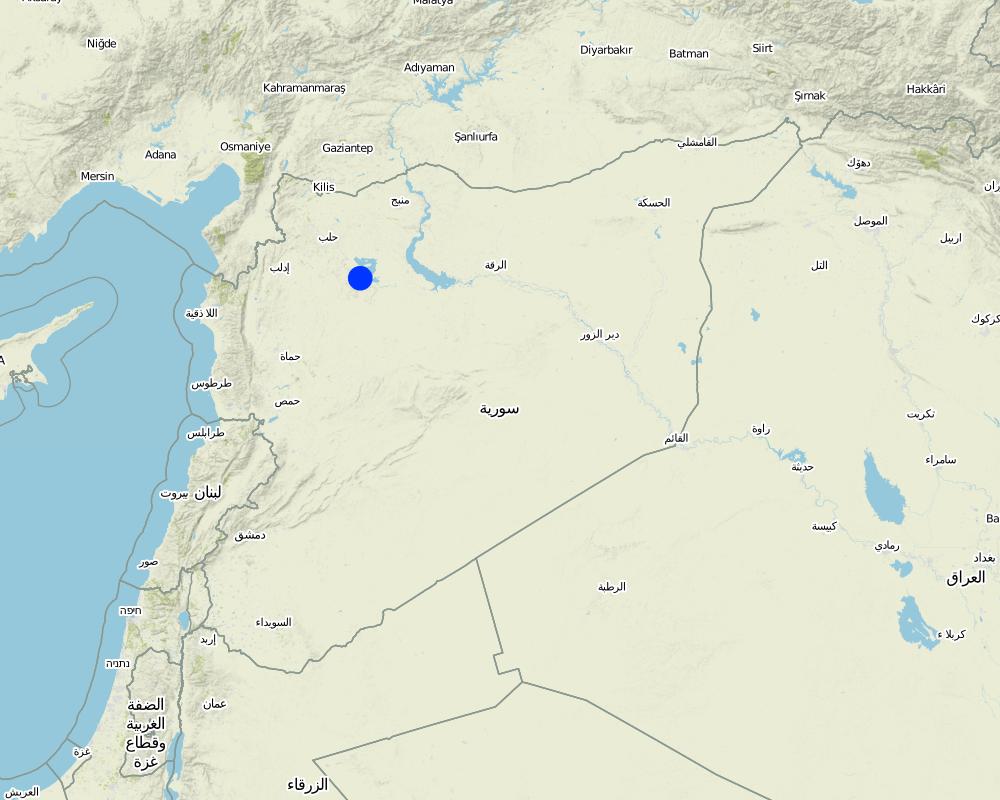Participatory technology development [Syrie]
- Création :
- Mise à jour :
- Compilateur : Francis Turkelboom
- Rédacteur : –
- Examinateur : David Streiff
approaches_2631 - Syrie
Voir les sections
Développer tout Réduire tout1. Informations générales
1.2 Coordonnées des personnes-ressources et des institutions impliquées dans l'évaluation et la documentation de l'Approche
Spécialiste GDT:
Tubeileh Ashraf
A.Tubeileh@cgiar.org
Syrie
Spécialiste GDT:
Bruggeman Adriana
The Cyprus Institute (CyI)
Nom du ou des institutions qui ont facilité la documentation/ l'évaluation de l'Approche (si pertinent)
The Cyprus Institute (The Cyprus Institute) - Chypre1.3 Conditions relatives à l'utilisation par WOCAT des données documentées
Le compilateur et la(les) personne(s) ressource(s) acceptent les conditions relatives à l'utilisation par WOCAT des données documentées:
Oui
1.4 Références au(x) questionnaire(s) sur les Technologies de GDT
2. Description de l'Approche de GDT
2.1 Courte description de l'Approche
Participatory technology development, through close researcher-farmer interaction, for sustainable land management of olive orchards in dry marginal areas.
2.2 Description détaillée de l'Approche
Description détaillée de l'Approche:
Aims / objectives: The purpose of participatory technology development is to gain from the synergy between indigenous knowledge and scientific expertise. The specific objective in this case was to develop and test water and land management techniques in order to sustainably improve olive production in a semi-arid area, while ensuring that the techniques were well adapted to local farming practices. The approach consists of group meetings, joint field trips, identification of local innovations, extension days, monitoring of farmer practices, and researcher-controlled experiments. The approach consists of a cycle with three major stages: a diagnostic phase, a testing phase, followed by monitoring and evaluation. In this case study, farmers were invited based on their interest in growing olives. Participation throughout the learning cycle was completely voluntary: no material or financial incentives were used (although they expected them in the beginning of the process). The role of farmers was to identify priority problems and potential solutions, to test new technologies on their farms, and to evaluate their suitability. Farmers observed the research experiment with water harvesting, and then adapted the technology to their needs. As shown, they built V-shaped bunds around their olive trees to capture rainwater runoff, but - contrary to the researchers??? suggestion - they continued to plough the olive orchards, as this is their standard weed control practice. Weeds attract sheep, lead to fires and compete for water with the olives. This simple runoff harvesting system is well adapted to farmers??? objectives, and their modification -the up-and-down slope furrows created through ploughing - actually serves to increase the efficiency of the water harvesting. The system is now being monitored by researchers to assess its technical and economic efficiency.
Methods: Improved farmer-researcher interaction helps farmers learn about a useful basic technique from researchers, while researchers learn in turn about potential improvements to the technology from local innovators. A community facilitator of ICARDA (International Centre for Agricultural Research in Dry Areas) facilitated the group discussions, and the researchers were asked to be open-minded to new approaches while conducting and monitoring field trials. The approach was tested by an interdisciplinary team of ICARDA as part of the ???Khanasser Valley Integrated Research Site???. This project aimed to develop local-adapted options for agriculture in dry marginal areas alongside a generally applicable integrated approach for sustainable land management in these zones.
2.3 Photos de l'approche
2.5 Pays/ région/ lieux où l'Approche a été appliquée
Pays:
Syrie
Région/ Etat/ Province:
Khanasser Valley
Autres spécifications du lieu :
NW Syria
Map
×2.7 Type d'Approche
- fondé sur un projet/ programme
2.8 Principaux objectifs de l'Approche
- design, test and disseminate alternative technologies adapted to local conditions - strengthen local knowledge of SWC measures - strengthen joint learning by farmers and researchers
The SLM Approach addressed the following problems: The lack of appropriate ways to develop sustainable technologies to remedy loss of runoff water and poor olive growth -in the context of low-input agriculture on gentle undulating land in water scarce areas with an absence of soil conservation measures.
2.9 Conditions favorisant ou entravant la mise en œuvre de la(des) Technologie(s) appliquée(s) sous l'Approche
disponibilité/ accès aux ressources et services financiers
- entrave
Water harvesting is considered expensive due to labour cost.
Treatment through the SLM Approach: Identification of a low-cost water harvesting measure, which can be implemented during the off-season. Cost-benefit analysis.
connaissances sur la GDT, accès aux supports techniques
- entrave
Difficulty in tilling the land when water harvesting structures are in place.
Treatment through the SLM Approach: Integrating local innovations into the water harvesting system.
autre
- entrave
Uncertainty about appropriate size of micro-catchment area. Uncertainty about the amount of water harvested. Lack of technical expertise for olive crop husbandry in dry areas.
Treatment through the SLM Approach: Researcher-controlled research and carry out farmer field days, desseminate and elaborate extension leaflets as a help.
3. Participation et rôles des parties prenantes impliquées dans l'Approche
3.1 Parties prenantes impliquées dans l'Approche et rôles
- exploitants locaux des terres / communautés locales
Mainly men were involved, as most activities in olive orchards are managed by men. In addition, culturally bound gender segregation in public makes it difficult to organise gender-mixed meetings. Therefore, separate meetings were organised for women. In the case of one household, the de facto partner was a woman who takes most of the orchard-related decisions and does the work herself.
- researchers
3.2 Participation des exploitants locaux des terres/ communautés locales aux différentes phases de l'Approche
| Participation des exploitants locaux des terres/ communautés locales | Spécifiez qui était impliqué et décrivez les activités | |
|---|---|---|
| initiation/ motivation | passive | public meetings |
| planification | interactive | public meetings |
| mise en œuvre | interactive | completely conducted by land-users |
| suivi/ évaluation | interactive | interviews/questionnaires, public meetings; |
| Research | interactive | on-farm; farmer experiments and controlled on-farm experiments |
3.3 Diagramme/ organigramme (si disponible)
3.4 Prises de décision pour la sélection de la Technologie/ des Technologies
Indiquez qui a décidé de la sélection de la Technologie/ des Technologies à mettre en œuvre:
- principalement les exploitants des terres soutenus par des spécialistes de la GDT
Expliquez:
Decisions on the method of implementing the SLM Technology were made by mainly by land users supported by SLM specialists
4. Soutien technique, renforcement des capacités et gestion des connaissances
4.1 Renforcement des capacités/ formation
Une formation a-t-elle été dispensée aux exploitants des terres/ autres parties prenantes?
Oui
Formats de la formation:
- sur le tas
- entre agriculteurs (d'exploitants à exploitants)
- réunions publiques
Thèmes abordés:
Demand-driven training of olive husbandry techniques (eg pruning, grafting, pest management)
4.2 Service de conseils
Les exploitants des terres ont-ils accès à un service de conseils?
Oui
Spécifiez si le service de conseils est fourni:
- dans les champs des exploitants?
Décrivez/ commentez:
Farmer-to-farmer extension; Key elements: innovative farmers showed their technique to other olive farmers during farm visits
4.3 Renforcement des institutions (développement organisationnel)
Des institutions ont elles été mises en place ou renforcées par le biais de l'Approche?
- non
4.4 Suivi et évaluation
Le suivi et l'évaluation font ils partie de l'Approche? :
Oui
Commentaires:
bio-physical aspects were regular monitored by 0 through observations; indicators: soil moisture
bio-physical aspects were regular monitored by 0 through measurements; indicators: water harvesting structures and management measures
technical aspects were regular monitored by None through observations; indicators: perceptions of the technology
socio-cultural aspects were ad hoc monitored by None through measurements; indicators: cost and benefits
economic / production aspects were ad hoc monitored by None through measurements; indicators: annual field survey using GPS
area treated aspects were regular monitored by None through measurements; indicators: annual farmer interview
no. of land users involved aspects were regular monitored by None through observations; indicators: None
There were few changes in the Approach as a result of monitoring and evaluation: There were few changes: interest in the farmers??? orchards and questions about the technology stimulated some other farmers to apply water harvesting.
4.5 Recherche
La recherche a-t-elle fait partie intégrante de l’Approche?
Oui
Spécifiez les thèmes:
- sociologie
- économie/ marketing
- technologie
Donnez plus de détails et indiquez qui a mené ces recherches:
Research was an important part of this approach. Technical and socio-economic topics were treated as follows: (1) Researcher-controlled on-farm experiments: this helped evaluate the impact of water harvesting design on the amount of water harvested and the olive crop response. (2) Monitoring of farmer-managed trials: to evaluate the performance of water harvesting under on-farm conditions. (3) Cos
5. Financement et soutien matériel externe
5.1 Budget annuel de la composante GDT de l'Approche
Commentez (par ex. principales sources de financement/ principaux bailleurs de fonds):
Approach costs were met by the following donors: government (national - ICARDA, Atomic Energy Commission Syria): 10.0%; international non-government (BMZ (Germany)): 50.0%; local community / land user(s) (-): 40.0%
5.2 Soutiens financiers/ matériels fournis aux exploitants des terres
Les exploitants des terres ont-ils reçu un soutien financier/ matériel pour la mise en œuvre de la Technologie/ des Technologies?
Oui
5.3 Subventions pour des intrants spécifiques (incluant la main d'œuvre)
Si la main d'œuvre fournie par les exploitants des terres était un intrant substantiel, elle était:
- volontaire
5.4 Crédits
Des crédits ont-ils été alloués à travers l'Approche pour les activités de GDT?
Non
6. Analyses d'impact et conclusions
6.1 Impacts de l'Approche
Est-ce que l'Approche a aidé les exploitants des terres à mettre en œuvre et entretenir les Technologies de GDT?
- Non
- Oui, un peu
- Oui, modérément
- Oui, beaucoup
Adoption of the furrow-enhanced runoff-water harvesting technique resulted in a concentration of scarce rainwater and nutrients in the basins around the olive trees. The consequence is a significant reduction of soil loss and runoff at the field level.
Did other land users / projects adopt the Approach?
- Non
- Oui, un peu
- Oui, modérément
- Oui, beaucoup
This approach is now being applied in other ICARDA-coordinated projects in the region.
6.3 Durabilité des activités de l'Approche
Les exploitants des terres peuvent-ils poursuivre ce qui a été mis en œuvre par le biais de l'Approche (sans soutien extérieur)?
- oui
Si oui, décrivez de quelle manière:
The complete PTD process/learning cycle needs outsider facilitation, but lack of outsiders will not stop farmers experimenting further by themselves. In terms of the technology itself, farmers can continue independently with water harvesting structures, as the system is very simple and relatively cheap.
6.4 Points forts/ avantages de l'Approche
| Points forts/ avantages/ possibilités du point de vue du compilateur ou d'une autre personne ressource clé |
|---|
| Engagement of researchers with local innovators and thus interaction between scientific and indigenous knowledge (How to sustain/ enhance this strength: This approach can only be sustained if it is mainstreamed into national research and extension services.) |
| Attitude changes by researchers about farmers??? knowledge (How to sustain/ enhance this strength: Ditto.) |
| Building on local knowledge (How to sustain/ enhance this strength: Ditto.) |
| Capacity building of both land users and researchers (How to sustain/ enhance this strength: Ditto.) |
| Demand-driven technologies (How to sustain/ enhance this strength: Ditto.) |
6.5 Faiblesses/ inconvénients de l'Approche et moyens de les surmonter
| Faiblesses/ inconvénients/ risques du point de vue du compilateur ou d'une autre personne ressource clé | Comment peuvent-ils être surmontés? |
|---|---|
| Time demanding | Less time needed after the first experience. |
| Appropriate facilitating skills required | Mainstreaming facilitation skills. |
7. Références et liens
7.1 Méthodes/ sources d'information
- visites de terrain, enquêtes sur le terrain
- interviews/entretiens avec les exploitants des terres
7.2 Références des publications disponibles
Titre, auteur, année, ISBN:
Tubeileh A and Turkelboom F (2004) Participatory research on water and soil management with olive growers in the Khanasservan Veldhuizen L, Waters-Bayer A, Abd de Zeeuw H (1997) Developing technology with farmers:
Liens et modules
Développer tout Réduire toutLiens
Aucun lien
Modules
Aucun module trouvé


